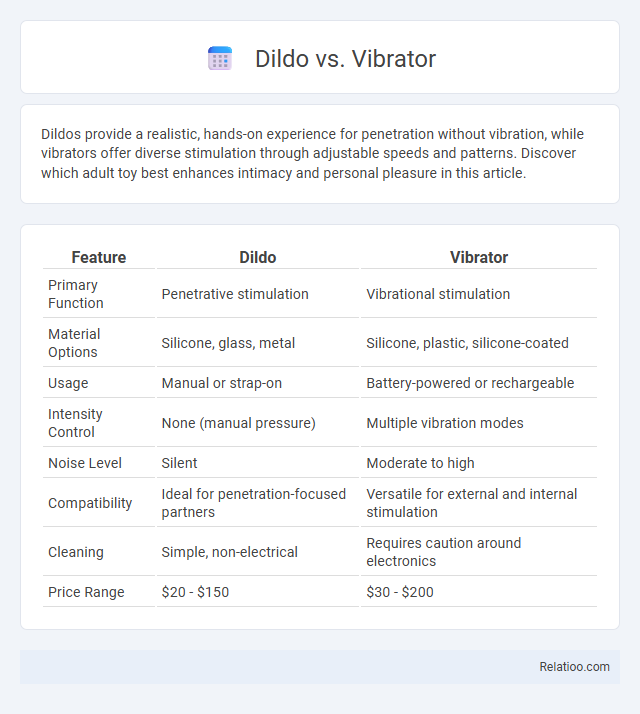Dildos provide a realistic, hands-on experience for penetration without vibration, while vibrators offer diverse stimulation through adjustable speeds and patterns. Discover which adult toy best enhances intimacy and personal pleasure in this article.
Table of Comparison
| Feature | Dildo | Vibrator |
|---|---|---|
| Primary Function | Penetrative stimulation | Vibrational stimulation |
| Material Options | Silicone, glass, metal | Silicone, plastic, silicone-coated |
| Usage | Manual or strap-on | Battery-powered or rechargeable |
| Intensity Control | None (manual pressure) | Multiple vibration modes |
| Noise Level | Silent | Moderate to high |
| Compatibility | Ideal for penetration-focused partners | Versatile for external and internal stimulation |
| Cleaning | Simple, non-electrical | Requires caution around electronics |
| Price Range | $20 - $150 | $30 - $200 |
Introduction: Understanding Dildos and Vibrators
Dildos and vibrators are two of the most popular types of sex toys, each serving unique purposes and preferences. Dildos are typically non-vibrating, designed primarily for penetration, while vibrators offer various stimulation modes with built-in motors for added sensations. Understanding the distinct features and uses of dildos and vibrators can guide users in selecting the ideal sex toy to enhance their intimate experiences.
Key Differences Between Dildos and Vibrators
Dildos and vibrators differ primarily in functionality; dildos are non-mechanical tools designed for penetration, while vibrators incorporate motors to provide various vibration patterns and intensities for enhanced stimulation. Material composition varies, with both often crafted from silicone, but vibrators require additional components like batteries or rechargeable engines to operate. Usage preferences hinge on sensation type, as dildos emphasize realistic feel and shape, whereas vibrators focus on added vibration to target erogenous zones.
Materials and Safety Considerations
Dildos are typically made from silicone, glass, or stainless steel, offering body-safe, non-porous surfaces that are easy to clean and hypoallergenic. Vibrators often include electronic components encased in silicone or ABS plastic, requiring careful attention to waterproof ratings and battery safety to prevent electrical hazards. Choosing sex toys made from medical-grade, phthalate-free materials ensures safe use and reduces the risk of infections, making hygiene and material transparency critical factors in selection.
Types and Varieties Available
Dildos offer a range of shapes, sizes, and materials, including realistic silicone and glass options, catering to different preferences for penetration and texture. Vibrators come in various types such as bullet, wand, and rabbit designs, each delivering unique vibration patterns and intensities for clitoral or internal stimulation. Your choice among sex toys expands further with hybrid models combining features of both dildos and vibrators, as well as specialty items tailored for specific erogenous zones and experiences.
How Dildos Are Used
Dildos are versatile sex toys primarily designed for penetration, available in various shapes, sizes, and materials to suit individual preferences. They can be used vaginally or anally, often employed for solo pleasure or partnered play, enhancing stimulation and intimacy. Unlike vibrators, which provide rhythmic vibrations, dildos rely on manual movement to deliver sensation and can be integrated with harnesses for hands-free use.
How Vibrators Are Used
Vibrators are primarily used for stimulating erogenous zones through consistent vibrations that enhance sexual pleasure and arousal. They come in various shapes and sizes, designed for external use on the clitoris or nipples, or internal use targeting the vaginal or anal areas. Unlike dildos, which mainly provide penetration, vibrators combine penetration with vibration to intensify sexual sensations and orgasms.
Pros and Cons of Dildos
Dildos offer a realistic and straightforward option for sexual pleasure, typically made from body-safe materials like silicone or glass, providing durability and ease of cleaning. Their main advantage lies in their simplicity, requiring no batteries or charging, which ensures consistent performance without noise, but they lack vibration features that some users may desire for enhanced stimulation. Your choice depends on whether you prioritize lifelike feel and low maintenance over the varied sensations a vibrator or multifunctional sex toy may provide.
Pros and Cons of Vibrators
Vibrators offer powerful stimulation and a variety of settings for customizable pleasure, catering to different preferences and enhancing sexual experiences, which makes them highly versatile compared to dildos and general sex toys. However, their reliance on batteries or charging can be inconvenient, and the electronic components may limit use in water unless specifically designed for waterproof functionality. Some users might find vibrators too intense or prefer the simpler, more natural feel of non-vibrating sex toys like dildos.
Choosing the Right Toy for Your Needs
Choosing the right sex toy depends on your personal preferences and desired sensations; dildos offer realistic penetration without vibration, ideal for those seeking straightforward stimulation, while vibrators provide varied intensity and patterns for enhanced clitoral or internal pleasure. Consider factors such as material safety, size, noise level, and whether you want external, internal, or dual stimulation to match your comfort and goals. Researching user reviews and understanding features like waterproof design or rechargeable battery life can further help tailor your choice to your lifestyle and sexual wellness needs.
Tips for Safe and Enjoyable Use
Choose body-safe materials like medical-grade silicone for dildos, vibrators, and other sex toys to minimize the risk of irritation or infection. Clean toys thoroughly before and after use with warm water and antibacterial soap or a specialized toy cleaner to maintain hygiene. Use water-based lubricants to enhance comfort and prevent damage to silicone surfaces while storing toys separately to avoid material degradation.

Infographic: Dildo vs Vibrator
 relatioo.com
relatioo.com